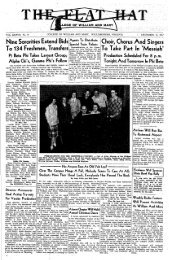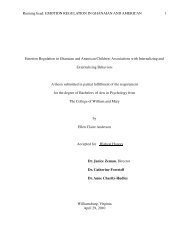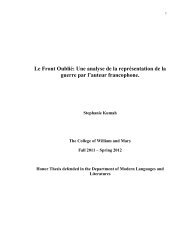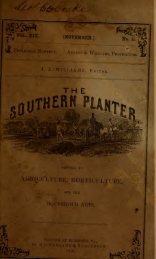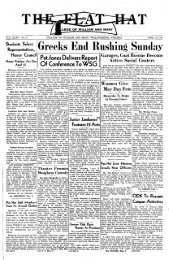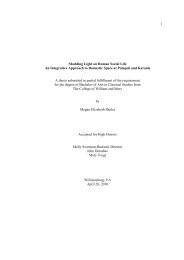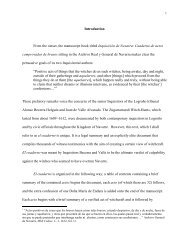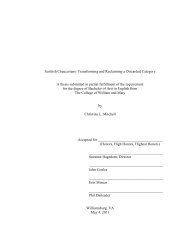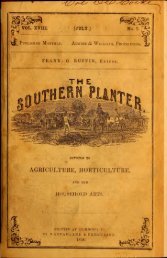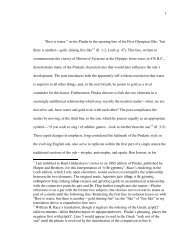Southern planter - The W&M Digital Archive
Southern planter - The W&M Digital Archive
Southern planter - The W&M Digital Archive
Create successful ePaper yourself
Turn your PDF publications into a flip-book with our unique Google optimized e-Paper software.
1859.] THE SOUTHERN PLANTER. 443<br />
any and every dog, little thinking the bad<br />
effect such treatment has upon future litters.<br />
In explanation of this phenomenon that<br />
eminent physiologist, Professor Carpenter,<br />
in his celebrated work upon " Human<br />
Physiology," writes :<br />
" Some of these cases<br />
appear referrable to the strong mental impressions<br />
left by 4 the first male parent upon<br />
the female ; but there are others which<br />
seem to render it more likely that the<br />
blood of the female has imbibed from that<br />
of the foetus, Ihrough the placental circulation,<br />
some of the attributes which the<br />
latter has derived from its male parent;<br />
and that the female may communicate these,<br />
with those proper to herself, to the subsequent<br />
offspring of a different male parent-<br />
age." <strong>The</strong> same author also writes<br />
" <strong>The</strong>re seems good reason to believe that<br />
the attributes of the germ are in great degree<br />
dependent not merely upon the habitual<br />
condition of the parents, which have<br />
furnished its original components, but even<br />
upon the condition in which those parents<br />
may be at time of sexual congress. Of<br />
this we have a remarkable proof in the<br />
phenomenon well known to breeders of<br />
horses, that a strong mental impression,<br />
made upon the female by a particular male,<br />
will give the offspring a resemblance to<br />
him, even though she had no sexual in-<br />
tercourse with him. In conclusion, allow<br />
me to say that agricultural societies are to<br />
be blamed very much for the little attention<br />
they pay to horses as compared with<br />
other stock, especially poultry. <strong>The</strong>y ought<br />
to give liberal prizes to the brood mares<br />
and stallions of all breeds, and pay as much<br />
attention to them—they deserve more—as<br />
to cattle, &c. <strong>The</strong> best stallion should<br />
have to travel within the district of the<br />
society during next season, and not to re-<br />
ceive the prize until the end of that time.<br />
I must add that our great landlords gen-<br />
erally overlook the interest of their ten-<br />
ants, and consequently their own also, in<br />
not keeping good thorough-bred stallions,<br />
of different breeds, for the use of their<br />
tenants at a nominal charge. Farmers<br />
themselves also overlook their own interest<br />
too often by being " penny wise and<br />
pound foolish," in looking more at the<br />
fee of the horse, when they engage him,<br />
than at his shape.<br />
Examine your pickles, sweet-meats, and<br />
everything put away.<br />
Treatment of Peach Trees.<br />
R. Seamans, of Cccilton, Maryland, thus<br />
gives his plan of treatment of peach trees,<br />
which he cultivates on a large scale :<br />
" <strong>The</strong>y should be carefully examined<br />
every year, and all the worms and ova destroyed.<br />
A shovelful of wood ashes thrown<br />
around the roots every spring is beneficial.<br />
When six years old, the soil should be cautiously<br />
removed for about two feet round<br />
the trunk, so as to examine the root. A<br />
strong wash of lime and some salt should<br />
then be applied to the top of the root at<br />
the trunk and for about eighteen inches<br />
above it, prior to which application the<br />
rough bark should be scraped off. <strong>The</strong> removed<br />
soil is left open for one week, then<br />
placed in its former position. A yearly examination<br />
for worms, a rich soil, and care-<br />
ful cultivation, are all necessary for the<br />
prosperity of the peach tree.<br />
Extirpating Thistles from Grass Land. -<br />
To me there have appeared few things<br />
more extraordinary in the history of farming<br />
knowledge than the perverse tenacity<br />
with which prejudice has so long preferred<br />
thef scythe to the roller in keeping down<br />
thistles. In the North Riding of Yorkshire,<br />
as far back as forty years ago, the<br />
roller was an approved instrument for destroying<br />
thistles in pasture grounds: and<br />
most effective it proved to be—the bruise<br />
and crush of the top of the plant extending<br />
in mortification to the root. No doubt<br />
of it, the scythe makes a clean sweep—so<br />
does a surgeon when he cuts a leg oft'; but<br />
let a crushed leg remain attached to the<br />
body, and the undertaker will assuredly<br />
have employment.<br />
Pitch Phenomenon at Sea.<br />
While the bark Holla, of New York,<br />
was in the Gulf of Mexico, on May 4th, it<br />
passed through a scum of smoking pitch,<br />
which extended for several miles, and emitted<br />
a most nauseating odour. It was supposed<br />
by her captain (Mr. Rogers) to be<br />
thrown up by' a submarine eruption from<br />
some part of the bottom of the ocean.<br />
This, we think, is the true explanation of<br />
the phenomenon. <strong>The</strong>re are extensive formations<br />
of mineral pitch in Cuba, Trinidad,<br />
and other West India islands, and no doubt<br />
there are beds of this material under the<br />
waters of the gulf. Scientific American.



